Week 16(1).pptx
Download as pptx, pdf0 likes4 views
Augmented reality (AR) superimposes digital content onto the real world in real time. There are two main types of AR technologies: marker-based AR uses images or codes that digital objects can be overlaid on, while marker-less AR uses location data to present virtual objects based on a user's location. AR has advantages for education by enabling visualization of concepts that are otherwise difficult to see, which can enhance understanding. It can also increase student motivation, attitudes, and academic achievement.
1 of 13
Download to read offline



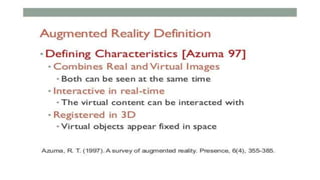
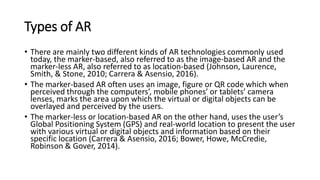

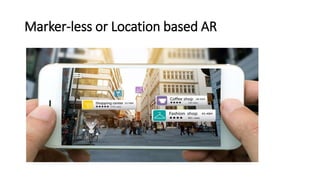
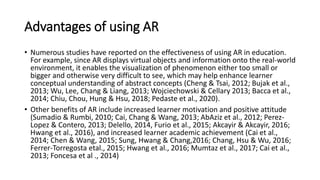
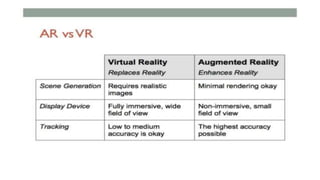
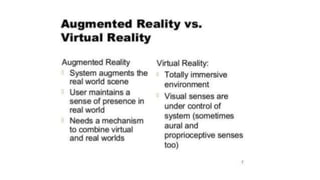
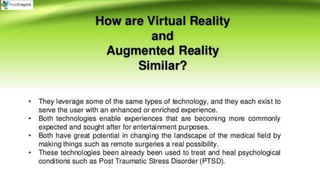
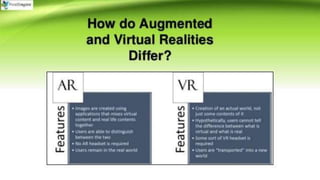
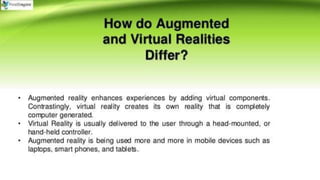
Recommended
AN APPLICATION OF PHYSICS EXPERIMENTS OF HIGH SCHOOL BY USING AUGMENTED REALITY
AN APPLICATION OF PHYSICS EXPERIMENTS OF HIGH SCHOOL BY USING AUGMENTED REALITYijseajournal
Ėý
This document discusses the application of augmented reality (AR) in enhancing physics education for high school students, aiming to improve teaching methods and the understanding of complex experiments. The study highlights the potential of AR to engage students and facilitate learning by providing interactive visual experiences through mobile applications. The authors emphasize the importance of usability and effective integration of AR into the educational curriculum to maximize its benefits."The Impact of Augmented Reality and Virtual Reality on Learning Styles in th...
"The Impact of Augmented Reality and Virtual Reality on Learning Styles in th...IRJET Journal
Ėý
This document summarizes a research paper that explores how augmented reality (AR) and virtual reality (VR) can impact learning styles in creative design education. It discusses how AR and VR can appeal to different learning styles like visual, auditory, and kinesthetic learners by making design concepts more interactive and experiential. However, using these technologies for education also presents challenges as not all students may have access to them and teachers need to adapt their teaching methods. Overall, the research finds that AR and VR have the potential to improve design education by making learning more engaging and interactive for all types of students.Mobile Augmented Reality Application for Primary School Education
Mobile Augmented Reality Application for Primary School Educationijma
Ėý
The document discusses the development of a mobile augmented reality application, 'belajarbacaansolat', aimed at enhancing primary school education in Islamic subjects, particularly in teaching prayers. It highlights the limitations of traditional teaching methods and proposes the AR-based application as a solution to engage students and improve their understanding through interactive learning experiences. The study outlines the methodology, technology used, and the anticipated benefits of integrating augmented reality into the learning process for both students and teachers.MOBILE AUGMENTED REALITY APPLICATION FOR PRIMARY SCHOOL EDUCATION
MOBILE AUGMENTED REALITY APPLICATION FOR PRIMARY SCHOOL EDUCATIONijma
Ėý
This document discusses the development of a mobile-based augmented reality application, 'belajarbacaansolat', aimed at improving primary school students' understanding of Islamic studies, specifically prayers, through interactive learning. It highlights the limitations of traditional learning methods and demonstrates how augmented reality technology can enhance engagement and comprehension by providing immersive, real-time learning experiences. The research outlines the framework, methodology, and testing of the application, emphasizing its potential benefits for both students and teachers in the educational process.Affordances of ict tool video assignment
Affordances of ict tool video assignmentDennis Pang Choon Guan
Ėý
The document discusses the concept of affordances in the context of virtual and augmented reality (VR/AR) as educational tools, outlining pedagogical, social, and technical affordances. It highlights how VR/AR can enhance learning through immersive experiences, enabling students to interact with 3D environments and improve their understanding of complex concepts. Additionally, the document includes examples of VR applications that promote engagement and facilitate knowledge construction in subjects like biology.Augmented Tourism: Definitions and Design Principles
Augmented Tourism: Definitions and Design Principlesjournal ijrtem
Ėý
This document discusses the design principles and implementation strategies of augmented reality (AR) in tourism, exploring its definition and affiliations with other technologies such as virtual reality and the Internet of Things. It outlines the benefits of AR for enhancing visitor experiences, including personalized content delivery, while addressing challenges like infrastructure demands and user adoption. Case studies highlight the applications of AR in various tourism contexts, including museums, libraries, and location-based gaming, ultimately proposing design frameworks to improve the effectiveness of AR in tourism settings.IRJET- Overview of Augmented Reality in Education
IRJET- Overview of Augmented Reality in EducationIRJET Journal
Ėý
This document provides an overview of augmented reality (AR) and its potential applications in education. It defines AR as superimposing digital information onto the real world in real-time. The document then covers four main types of AR and provides examples. It discusses the importance of AR for learning as it can make abstract concepts more concrete and engaging for students. Examples of using AR in classrooms, for homework, and virtual labs are presented. Both the benefits of AR in education, such as interactivity and motivation, and limitations, such as technical issues, are outlined. The document concludes that AR has great potential to enhance learning once technical challenges are addressed.A systematic review of immersive virtual reality applications for higher educ...
A systematic review of immersive virtual reality applications for higher educ...eraser Juan JosÃĐ CalderÃģn
Ėý
This document presents a systematic review of immersive virtual reality (VR) applications in higher education, identifying key design elements, learning theories, and gaps in existing research. It discusses the current use of both high-end and budget-friendly head-mounted displays as well as the importance of evaluating learning outcomes beyond usability. The study aims to guide future research by highlighting the potential of VR applications across 18 various educational domains while pointing out the neglect of relevant learning theories in the development of these applications.BT4098_PPT.pdfsehtsxudyxrtgfhdrtjxhfxftr
BT4098_PPT.pdfsehtsxudyxrtgfhdrtjxhfxftrshreyansh123405
Ėý
The document discusses a virtual reality (VR) learning application that enhances educational experiences through immersive environments, allowing multi-sensory interaction and engagement. It highlights the advantages of VR over traditional methods, emphasizing its effectiveness in facilitating active learning and improving information retention. The proposed application combines various VR technologies to create realistic virtual environments for diverse educational purposes, ultimately aiming to improve student focus and engagement.39335591.pdf
39335591.pdfparulian
Ėý
This document summarizes a research paper on using virtual and augmented reality in education. The paper provides a literature review on VR and AR, analyzing their implementation in educational models. It then proposes a model for developing integrated learning objects using VR and AR. The model involves designing, introducing, exploring, constructing, and sharing VR and AR learning objects that can be integrated into other educational content. To validate this model, the paper describes an experiment comparing its features to existing virtual learning environments. The results suggest the model could effectively integrate VR and AR learning objects into educational platforms and environments.How education industry will be affected by AR/ VR technology
How education industry will be affected by AR/ VR technologySayad Shahanawaz
Ėý
The document discusses the impact of augmented reality (AR) and virtual reality (VR) on the education industry, highlighting their roles in enhancing learning experiences. AR allows for interactive and engaging learning by superimposing digital content onto the real world, while VR creates immersive simulated environments for exploration. Both technologies have been shown to improve efficiency and interest in education, paving the way for innovative educational approaches.New Era of Teaching Learning : 3D Marker Based Augmented Reality
New Era of Teaching Learning : 3D Marker Based Augmented Realityijistjournal
Ėý
The paper discusses the use of 3D marker-based augmented reality (AR) as an innovative educational tool that enhances students' understanding of concepts through real-life visual aids. It emphasizes the importance of transitioning from traditional 2D teaching methods to more interactive 3D environments, thereby engaging learners and improving their educational outcomes. The study's results show a significant improvement in student performance when utilizing AR, suggesting its potential to revolutionize educational practices.COMP 4010 Lecture12 Research Directions in AR
COMP 4010 Lecture12 Research Directions in ARMark Billinghurst
Ėý
This document discusses the evolution and future directions of augmented reality (AR) research, focusing on display technologies, tracking innovations, and interaction methods. It highlights advancements from earlier bulky displays to lightweight, projected, and retinal displays, as well as enhanced tracking techniques and multimodal interaction approaches. The document also emphasizes the need for further research in collaborative experiences, social acceptance, cloud services, and content creation tools for non-experts.presentation for Augumented Reality
presentation for Augumented RealityPreetamaMaharana
Ėý
Augmented reality (AR) enhances the real world by overlaying digital elements such as images and 3D models, facilitating better interaction and perception. Since its invention by Tom Caudell in 1990, AR has numerous applications in education, healthcare, and gaming, though it presents challenges such as high costs and potential health risks. Overall, AR signifies a significant advancement in the digital realm, promising to transform how we experience our environments.VIRTUAL AND AUGMENTED REALITY IN THE PRESENT SCENARIO
VIRTUAL AND AUGMENTED REALITY IN THE PRESENT SCENARIOIRJET Journal
Ėý
The document discusses virtual and augmented reality technologies and their applications in education. It describes how VR and AR can be used to immerse students in virtual environments to help teach complex concepts in a more engaging way. Examples are given of how medical and engineering students can use VR and AR to better understand human anatomy and collaborate on projects. The document also outlines some of the tools and techniques used to create VR and AR content, as well as how AI can enhance interactivity. Two case studies are presented on using VR and AR with local students to teach about solar systems and human anatomy. The conclusion is that these technologies increase student engagement and benefit learning.COMP 4010 - Lecture11 - AR Applications
COMP 4010 - Lecture11 - AR ApplicationsMark Billinghurst
Ėý
The document covers a lecture on augmented reality (AR) applications by Bruce Thomas and Mark Billinghurst, highlighting the growth of the AR business and potential future applications across various sectors including education, marketing, and cultural heritage. It emphasizes the importance of user acceptance, the need for immersive collaboration through AR tools, and presents case studies like the visualization of Christchurch post-earthquake. The discussion also touches on AR's role in enhancing communication and empathy through technology, pointing out both successes and challenges in implementation. Risks of interactive communication in adolescents. Digital literacy diagnosi...
Risks of interactive communication in adolescents. Digital literacy diagnosi...Education in the Knowledge Society PhD
Ėý
The doctoral thesis by Isabel RodrÃguez de Dios focuses on improving digital literacy and skills in adolescents to navigate online risks and maximize opportunities. It explores the relationships between parental mediation, digital skills, and online risks/opportunities through empirical studies, culminating in the development of a mobile application aimed at enhancing personal security skills and coping strategies. The thesis contains a comprehensive theoretical framework and three studies that validate a digital literacy scale and investigate the impacts of parental mediation on adolescents' online behavior.Virtual Reality: A Technology Benefiting Students
Virtual Reality: A Technology Benefiting Studentssamhauck
Ėý
This document discusses the benefits of using virtual reality in education. It begins with an overview of studies showing virtual reality can increase student engagement and learning retention. While some argue VR only benefits games and can increase aggression, the document asserts VR has potential to engage students and allow skills practice without risk of harm. The purpose is to explore VR benefits in education. It then provides background on VR history from the 1800s to modern headsets. Benefits discussed include increased student engagement, hands-on training without risk in fields like medicine, opportunities to experience things not otherwise possible, and teaching empathy. The document makes the case that VR positively impacts education when used appropriately.Implementation of Interactive Augmented Reality in 3D Assembly Design Present...
Implementation of Interactive Augmented Reality in 3D Assembly Design Present...AIRCC Publishing Corporation
Ėý
The paper presents a method for creating interactive 3D augmented reality (AR) scenes for assembly design presentations using marker-based camera tracking and software tools like BuildAR Pro and SolidWorks. It highlights the advantages of AR in enhancing user interaction with designs, improving understanding of complex structures, and providing real-time feedback during the design process. The proposed approach aims to merge virtual components with real-world settings to facilitate better comprehension in both training and marketing contexts.IMPLEMENTATION OF INTERACTIVE AUGMENTED REALITY IN 3D ASSEMBLY DESIGN PRESENT...
IMPLEMENTATION OF INTERACTIVE AUGMENTED REALITY IN 3D ASSEMBLY DESIGN PRESENT...AIRCC Publishing Corporation
Ėý
The document discusses implementing interactive augmented reality for 3D assembly design presentations. It proposes an approach to create augmented reality scenes that allow users to interact with virtual assembly components and animations in the real world. The approach uses marker-based camera tracking with BuildAR Pro software to overlay animated CAD assembly designs created in SolidWorks and 3ds max onto physical markers. This allows users to view and manipulate virtual assembly components relative to the markers in real-time, enhancing understanding of complex assemblies.IMPLEMENTATION OF INTERACTIVE AUGMENTED REALITY IN 3D ASSEMBLY DESIGN PRESENT...
IMPLEMENTATION OF INTERACTIVE AUGMENTED REALITY IN 3D ASSEMBLY DESIGN PRESENT...ijcsit
Ėý
This paper discusses an approach to implementing interactive augmented reality (AR) in 3D assembly design presentations, highlighting the use of BuildAR Pro software with marker-based camera tracking and SolidWorks for CAD designs. The study emphasizes the advantages of integrating animated assembly designs within AR applications, thereby enhancing user interaction and comprehension of complex structures throughout various phases of design and manufacturing. The findings suggest that animated AR can significantly improve training, marketing, and presentational purposes in industries relying on CAD technologies.DIGITAL_DIMENSIONS.pptx.ppt ppt for vr and ar
DIGITAL_DIMENSIONS.pptx.ppt ppt for vr and arriteshhumein
Ėý
Virtual reality (VR) immerses users in a digital environment, while augmented reality (AR) overlays digital content onto the real world, both transforming interactions with technology. Applications range from gaming and education for VR to retail and navigation for AR, enhancing experiences through immersive and interactive elements. Despite challenges like cost and technical limitations, advancements in VR and AR technologies promise to blur the lines between real and virtual worlds, leading to innovative applications.Wearable Computing ėë, íëŦížėžëĄėė AR(ėĶę°íėĪ)ė ëđė
Wearable Computing ėë, íëŦížėžëĄėė AR(ėĶę°íėĪ)ė ëđė Mark Kim
Ėý
The document discusses the future of wearable computing and augmented reality, defining augmented reality, exploring current and potential use cases for augmented reality across various industries, and examining challenges and opportunities for augmented reality and wearable computing technologies going forward as platforms for augmented reality experiences.Augmented reality the evolution of human computer interaction
Augmented reality the evolution of human computer interactionBello Abubakar
Ėý
Augmented Reality: An Evolution in Human-Computer Interaction
This document discusses augmented reality (AR), which overlays digital information on the physical world. AR works by sensing the environment using cameras and sensors, augmenting it by identifying objects and context, and presenting additional information through displays. Common AR applications include mobile apps that provide information about objects by taking photos. The document also discusses how AR is used in education and training by bringing digital content into the real world through books, games and simulations. As AR systems expand, managing complex interactions and information across different tiers becomes important for scalability, interoperability and flexibility.Virtual Reality in Education
Virtual Reality in EducationBhavesh Joshi
Ėý
The document discusses the application of virtual reality (VR) and augmented reality (AR) in education, emphasizing their potential to enhance learning experiences through immersive simulations, virtual field trips, and interactive environments. VR can aid in training, remote learning, and collaboration, providing students with hands-on experiences that improve understanding of complex subjects. It also proposes the use of a 3D virtual interface in classrooms, suggesting that advanced AI systems could further personalize and enhance the learning environment.immersivestudio.co.uk-The Implications of Augmented Reality in Education.pdf
immersivestudio.co.uk-The Implications of Augmented Reality in Education.pdfImmersive Studio
Ėý
The document discusses the transformative potential of augmented reality (AR) in higher education, highlighting its ability to enhance student engagement, improve understanding, and foster collaboration. AR can facilitate personalized learning experiences through interactive content, while offering tools such as immersive rooms and wayfinding apps tailored to university settings. Immersive Studio specializes in developing AR solutions to support diverse educational needs and enhance curriculum delivery.IRJET - Application of AR in Education
IRJET - Application of AR in EducationIRJET Journal
Ėý
This document discusses the potential applications of augmented reality (AR) in education. It begins by introducing AR and how it can make learning more engaging by allowing students to see 3D objects overlayed on the real world. The document then reviews related literature that has found AR and virtual reality can improve learning outcomes in fields like engineering education. It discusses how AR could help address challenges in remote areas by providing educational resources. The document concludes by stating the goal of developing an AR system to help students better understand difficult concepts by rendering them in 3D.HistoPathology Ppt. Arshita Gupta for Diploma
HistoPathology Ppt. Arshita Gupta for Diplomaarshitagupta674
Ėý
Hello everyone please suggest your views and likes so that I uploaded more study materials
In this slide full HistoPathology according to diploma course available like fixation
Tissue processing , staining etc
University of Ghana Cracks Down on Misconduct: Over 100 Students Sanctioned
University of Ghana Cracks Down on Misconduct: Over 100 Students SanctionedKweku Zurek
Ėý
University of Ghana Cracks Down on Misconduct: Over 100 Students Sanctioned
More Related Content
Similar to Week 16(1).pptx (20)
BT4098_PPT.pdfsehtsxudyxrtgfhdrtjxhfxftr
BT4098_PPT.pdfsehtsxudyxrtgfhdrtjxhfxftrshreyansh123405
Ėý
The document discusses a virtual reality (VR) learning application that enhances educational experiences through immersive environments, allowing multi-sensory interaction and engagement. It highlights the advantages of VR over traditional methods, emphasizing its effectiveness in facilitating active learning and improving information retention. The proposed application combines various VR technologies to create realistic virtual environments for diverse educational purposes, ultimately aiming to improve student focus and engagement.39335591.pdf
39335591.pdfparulian
Ėý
This document summarizes a research paper on using virtual and augmented reality in education. The paper provides a literature review on VR and AR, analyzing their implementation in educational models. It then proposes a model for developing integrated learning objects using VR and AR. The model involves designing, introducing, exploring, constructing, and sharing VR and AR learning objects that can be integrated into other educational content. To validate this model, the paper describes an experiment comparing its features to existing virtual learning environments. The results suggest the model could effectively integrate VR and AR learning objects into educational platforms and environments.How education industry will be affected by AR/ VR technology
How education industry will be affected by AR/ VR technologySayad Shahanawaz
Ėý
The document discusses the impact of augmented reality (AR) and virtual reality (VR) on the education industry, highlighting their roles in enhancing learning experiences. AR allows for interactive and engaging learning by superimposing digital content onto the real world, while VR creates immersive simulated environments for exploration. Both technologies have been shown to improve efficiency and interest in education, paving the way for innovative educational approaches.New Era of Teaching Learning : 3D Marker Based Augmented Reality
New Era of Teaching Learning : 3D Marker Based Augmented Realityijistjournal
Ėý
The paper discusses the use of 3D marker-based augmented reality (AR) as an innovative educational tool that enhances students' understanding of concepts through real-life visual aids. It emphasizes the importance of transitioning from traditional 2D teaching methods to more interactive 3D environments, thereby engaging learners and improving their educational outcomes. The study's results show a significant improvement in student performance when utilizing AR, suggesting its potential to revolutionize educational practices.COMP 4010 Lecture12 Research Directions in AR
COMP 4010 Lecture12 Research Directions in ARMark Billinghurst
Ėý
This document discusses the evolution and future directions of augmented reality (AR) research, focusing on display technologies, tracking innovations, and interaction methods. It highlights advancements from earlier bulky displays to lightweight, projected, and retinal displays, as well as enhanced tracking techniques and multimodal interaction approaches. The document also emphasizes the need for further research in collaborative experiences, social acceptance, cloud services, and content creation tools for non-experts.presentation for Augumented Reality
presentation for Augumented RealityPreetamaMaharana
Ėý
Augmented reality (AR) enhances the real world by overlaying digital elements such as images and 3D models, facilitating better interaction and perception. Since its invention by Tom Caudell in 1990, AR has numerous applications in education, healthcare, and gaming, though it presents challenges such as high costs and potential health risks. Overall, AR signifies a significant advancement in the digital realm, promising to transform how we experience our environments.VIRTUAL AND AUGMENTED REALITY IN THE PRESENT SCENARIO
VIRTUAL AND AUGMENTED REALITY IN THE PRESENT SCENARIOIRJET Journal
Ėý
The document discusses virtual and augmented reality technologies and their applications in education. It describes how VR and AR can be used to immerse students in virtual environments to help teach complex concepts in a more engaging way. Examples are given of how medical and engineering students can use VR and AR to better understand human anatomy and collaborate on projects. The document also outlines some of the tools and techniques used to create VR and AR content, as well as how AI can enhance interactivity. Two case studies are presented on using VR and AR with local students to teach about solar systems and human anatomy. The conclusion is that these technologies increase student engagement and benefit learning.COMP 4010 - Lecture11 - AR Applications
COMP 4010 - Lecture11 - AR ApplicationsMark Billinghurst
Ėý
The document covers a lecture on augmented reality (AR) applications by Bruce Thomas and Mark Billinghurst, highlighting the growth of the AR business and potential future applications across various sectors including education, marketing, and cultural heritage. It emphasizes the importance of user acceptance, the need for immersive collaboration through AR tools, and presents case studies like the visualization of Christchurch post-earthquake. The discussion also touches on AR's role in enhancing communication and empathy through technology, pointing out both successes and challenges in implementation. Risks of interactive communication in adolescents. Digital literacy diagnosi...
Risks of interactive communication in adolescents. Digital literacy diagnosi...Education in the Knowledge Society PhD
Ėý
The doctoral thesis by Isabel RodrÃguez de Dios focuses on improving digital literacy and skills in adolescents to navigate online risks and maximize opportunities. It explores the relationships between parental mediation, digital skills, and online risks/opportunities through empirical studies, culminating in the development of a mobile application aimed at enhancing personal security skills and coping strategies. The thesis contains a comprehensive theoretical framework and three studies that validate a digital literacy scale and investigate the impacts of parental mediation on adolescents' online behavior.Virtual Reality: A Technology Benefiting Students
Virtual Reality: A Technology Benefiting Studentssamhauck
Ėý
This document discusses the benefits of using virtual reality in education. It begins with an overview of studies showing virtual reality can increase student engagement and learning retention. While some argue VR only benefits games and can increase aggression, the document asserts VR has potential to engage students and allow skills practice without risk of harm. The purpose is to explore VR benefits in education. It then provides background on VR history from the 1800s to modern headsets. Benefits discussed include increased student engagement, hands-on training without risk in fields like medicine, opportunities to experience things not otherwise possible, and teaching empathy. The document makes the case that VR positively impacts education when used appropriately.Implementation of Interactive Augmented Reality in 3D Assembly Design Present...
Implementation of Interactive Augmented Reality in 3D Assembly Design Present...AIRCC Publishing Corporation
Ėý
The paper presents a method for creating interactive 3D augmented reality (AR) scenes for assembly design presentations using marker-based camera tracking and software tools like BuildAR Pro and SolidWorks. It highlights the advantages of AR in enhancing user interaction with designs, improving understanding of complex structures, and providing real-time feedback during the design process. The proposed approach aims to merge virtual components with real-world settings to facilitate better comprehension in both training and marketing contexts.IMPLEMENTATION OF INTERACTIVE AUGMENTED REALITY IN 3D ASSEMBLY DESIGN PRESENT...
IMPLEMENTATION OF INTERACTIVE AUGMENTED REALITY IN 3D ASSEMBLY DESIGN PRESENT...AIRCC Publishing Corporation
Ėý
The document discusses implementing interactive augmented reality for 3D assembly design presentations. It proposes an approach to create augmented reality scenes that allow users to interact with virtual assembly components and animations in the real world. The approach uses marker-based camera tracking with BuildAR Pro software to overlay animated CAD assembly designs created in SolidWorks and 3ds max onto physical markers. This allows users to view and manipulate virtual assembly components relative to the markers in real-time, enhancing understanding of complex assemblies.IMPLEMENTATION OF INTERACTIVE AUGMENTED REALITY IN 3D ASSEMBLY DESIGN PRESENT...
IMPLEMENTATION OF INTERACTIVE AUGMENTED REALITY IN 3D ASSEMBLY DESIGN PRESENT...ijcsit
Ėý
This paper discusses an approach to implementing interactive augmented reality (AR) in 3D assembly design presentations, highlighting the use of BuildAR Pro software with marker-based camera tracking and SolidWorks for CAD designs. The study emphasizes the advantages of integrating animated assembly designs within AR applications, thereby enhancing user interaction and comprehension of complex structures throughout various phases of design and manufacturing. The findings suggest that animated AR can significantly improve training, marketing, and presentational purposes in industries relying on CAD technologies.DIGITAL_DIMENSIONS.pptx.ppt ppt for vr and ar
DIGITAL_DIMENSIONS.pptx.ppt ppt for vr and arriteshhumein
Ėý
Virtual reality (VR) immerses users in a digital environment, while augmented reality (AR) overlays digital content onto the real world, both transforming interactions with technology. Applications range from gaming and education for VR to retail and navigation for AR, enhancing experiences through immersive and interactive elements. Despite challenges like cost and technical limitations, advancements in VR and AR technologies promise to blur the lines between real and virtual worlds, leading to innovative applications.Wearable Computing ėë, íëŦížėžëĄėė AR(ėĶę°íėĪ)ė ëđė
Wearable Computing ėë, íëŦížėžëĄėė AR(ėĶę°íėĪ)ė ëđė Mark Kim
Ėý
The document discusses the future of wearable computing and augmented reality, defining augmented reality, exploring current and potential use cases for augmented reality across various industries, and examining challenges and opportunities for augmented reality and wearable computing technologies going forward as platforms for augmented reality experiences.Augmented reality the evolution of human computer interaction
Augmented reality the evolution of human computer interactionBello Abubakar
Ėý
Augmented Reality: An Evolution in Human-Computer Interaction
This document discusses augmented reality (AR), which overlays digital information on the physical world. AR works by sensing the environment using cameras and sensors, augmenting it by identifying objects and context, and presenting additional information through displays. Common AR applications include mobile apps that provide information about objects by taking photos. The document also discusses how AR is used in education and training by bringing digital content into the real world through books, games and simulations. As AR systems expand, managing complex interactions and information across different tiers becomes important for scalability, interoperability and flexibility.Virtual Reality in Education
Virtual Reality in EducationBhavesh Joshi
Ėý
The document discusses the application of virtual reality (VR) and augmented reality (AR) in education, emphasizing their potential to enhance learning experiences through immersive simulations, virtual field trips, and interactive environments. VR can aid in training, remote learning, and collaboration, providing students with hands-on experiences that improve understanding of complex subjects. It also proposes the use of a 3D virtual interface in classrooms, suggesting that advanced AI systems could further personalize and enhance the learning environment.immersivestudio.co.uk-The Implications of Augmented Reality in Education.pdf
immersivestudio.co.uk-The Implications of Augmented Reality in Education.pdfImmersive Studio
Ėý
The document discusses the transformative potential of augmented reality (AR) in higher education, highlighting its ability to enhance student engagement, improve understanding, and foster collaboration. AR can facilitate personalized learning experiences through interactive content, while offering tools such as immersive rooms and wayfinding apps tailored to university settings. Immersive Studio specializes in developing AR solutions to support diverse educational needs and enhance curriculum delivery.IRJET - Application of AR in Education
IRJET - Application of AR in EducationIRJET Journal
Ėý
This document discusses the potential applications of augmented reality (AR) in education. It begins by introducing AR and how it can make learning more engaging by allowing students to see 3D objects overlayed on the real world. The document then reviews related literature that has found AR and virtual reality can improve learning outcomes in fields like engineering education. It discusses how AR could help address challenges in remote areas by providing educational resources. The document concludes by stating the goal of developing an AR system to help students better understand difficult concepts by rendering them in 3D. Risks of interactive communication in adolescents. Digital literacy diagnosi...
Risks of interactive communication in adolescents. Digital literacy diagnosi...Education in the Knowledge Society PhD
Ėý
Implementation of Interactive Augmented Reality in 3D Assembly Design Present...
Implementation of Interactive Augmented Reality in 3D Assembly Design Present...AIRCC Publishing Corporation
Ėý
IMPLEMENTATION OF INTERACTIVE AUGMENTED REALITY IN 3D ASSEMBLY DESIGN PRESENT...
IMPLEMENTATION OF INTERACTIVE AUGMENTED REALITY IN 3D ASSEMBLY DESIGN PRESENT...AIRCC Publishing Corporation
Ėý
Recently uploaded (20)
HistoPathology Ppt. Arshita Gupta for Diploma
HistoPathology Ppt. Arshita Gupta for Diplomaarshitagupta674
Ėý
Hello everyone please suggest your views and likes so that I uploaded more study materials
In this slide full HistoPathology according to diploma course available like fixation
Tissue processing , staining etc
University of Ghana Cracks Down on Misconduct: Over 100 Students Sanctioned
University of Ghana Cracks Down on Misconduct: Over 100 Students SanctionedKweku Zurek
Ėý
University of Ghana Cracks Down on Misconduct: Over 100 Students Sanctioned
THE PSYCHOANALYTIC OF THE BLACK CAT BY EDGAR ALLAN POE (1).pdf
THE PSYCHOANALYTIC OF THE BLACK CAT BY EDGAR ALLAN POE (1).pdfnabilahk908
Ėý
Psychoanalytic Analysis of The Black Cat by Edgar Allan Poe explores the deep psychological dimensions of the narratorâs disturbed mind through the lens of Sigmund Freudâs psychoanalytic theory. According to Freud (1923), the human psyche is structured into three components: the Id, which contains primitive and unconscious desires; the Ego, which operates on the reality principle and mediates between the Id and the external world; and the Superego, which reflects internalized moral standards.
In this story, Poe presents a narrator who experiences a psychological breakdown triggered by repressed guilt, aggression, and internal conflict. This analysis focuses not only on the gothic horror elements of the narrative but also on the narratorâs mental instability and emotional repression, demonstrating how the imbalance of these three psychic forces contributes to his downfall.How to Manage Different Customer Addresses in Odoo 18 Accounting
How to Manage Different Customer Addresses in Odoo 18 AccountingCeline George
Ėý
A business often have customers with multiple locations such as office, warehouse, home addresses and this feature allows us to associate with different addresses with each customer streamlining the process of creating sales order invoices and delivery orders.2025 June Year 9 Presentation: Subject selection.pptx
2025 June Year 9 Presentation: Subject selection.pptxmansk2
Ėý
2025 June Year 9 Presentation: Subject selectionOBSESSIVE COMPULSIVE DISORDER.pptx IN 5TH SEMESTER B.SC NURSING, 2ND YEAR GNM...
OBSESSIVE COMPULSIVE DISORDER.pptx IN 5TH SEMESTER B.SC NURSING, 2ND YEAR GNM...parmarjuli1412
Ėý
OBSESSIVE COMPULSIVE DISORDER INCLUDED TOPICS ARE INTRODUCTION, DEFINITION OF OBSESSION, DEFINITION OF COMPULSION, MEANING OF OBSESSION AND COMPULSION, DEFINITION OF OBSESSIVE COMPULSIVE DISORDER, EPIDERMIOLOGY OF OCD, ETIOLOGICAL FACTORS OF OCD, CLINICAL SIGN AND SYMPTOMS OF OBSESSION AND COMPULSION, MANAGEMENT INCLUDED PHARMACOTHERAPY(ANTIDEPRESSANT DRUG+ANXIOLYTIC DRUGS), PSYCHOTHERAPY, NURSING MANAGEMENT(ASSESSMENT+DIAGNOSIS+NURSING INTERVENTION+EVALUATION)) Gladiolous Cultivation practices by AKL.pdf
Gladiolous Cultivation practices by AKL.pdfkushallamichhame
Ėý
This includes the overall cultivation practices of Rose prepared by:
Kushal Lamichhane (AKL)
Instructor
Shree Gandhi Adarsha Secondary School
Kageshowri Manohara-09, Kathmandu, Nepal
How to use search fetch method in Odoo 18
How to use search fetch method in Odoo 18Celine George
Ėý
The search_fetch is a powerful ORM method used in Odoo for some specific addons to combine the functionality of search and read for more efficient data fetching. It might be used to search for records and fetch specific fields in a single call. It stores the result in the cache memory.Vitamin and Nutritional Deficiencies.pptx
Vitamin and Nutritional Deficiencies.pptxVishal Chanalia
Ėý
Vitamin and nutritional deficiency occurs when the body does not receive enough essential nutrients, such as vitamins and minerals, needed for proper functioning. This can lead to various health problems, including weakened immunity, stunted growth, fatigue, poor wound healing, cognitive issues, and increased susceptibility to infections and diseases. Long-term deficiencies can cause serious and sometimes irreversible health complications.Public Health For The 21st Century 1st Edition Judy Orme Jane Powell
Public Health For The 21st Century 1st Edition Judy Orme Jane Powelltrjnesjnqg7801
Ėý
Public Health For The 21st Century 1st Edition Judy Orme Jane Powell
Public Health For The 21st Century 1st Edition Judy Orme Jane Powell
Public Health For The 21st Century 1st Edition Judy Orme Jane PowellM&A5 Q1 1 differentiate evolving early Philippine conventional and contempora...
M&A5 Q1 1 differentiate evolving early Philippine conventional and contempora...ErlizaRosete
Ėý
MAPEH 6 QI WEEK IPeer Teaching Observations During School Internship
Peer Teaching Observations During School InternshipAjayaMohanty7
Ėý
FOR B.ED,M.ED,M.A.EDUCATION AND ANY STUDENT OF TEACHER EDUCATIONHow payment terms are configured in Odoo 18
How payment terms are configured in Odoo 18Celine George
Ėý
Payment terms in Odoo 18 help define the conditions for when invoices are due. This feature can split payments into multiple parts and automate due dates based on specific rules.Q1_ENGLISH_PPT_WEEK 1 power point grade 3 Quarter 1 week 1
Q1_ENGLISH_PPT_WEEK 1 power point grade 3 Quarter 1 week 1jutaydeonne
Ėý
Grade 3 Quarter 1 Week 1 English part 2VCE Literature Section A Exam Response Guide
VCE Literature Section A Exam Response Guidejpinnuck
Ėý
This practical guide shows students of Unit 3&4 VCE Literature how to write responses to Section A of the exam. Including a range of examples writing about different types of texts, this guide:
*Breaks down and explains what Q1 and Q2 tasks involve and expect
*Breaks down example responses for each question
*Explains and scaffolds students to write responses for each question
*Includes a comprehensive range of sentence starters and vocabulary for responding to each question
*Includes critical theory vocabularyĖý lists to support Q2 responsesHow to Customize Quotation Layouts in Odoo 18
How to Customize Quotation Layouts in Odoo 18Celine George
Ėý
Customizing quotation layouts in Odoo 18 allows businesses to personalize their quotations to match branding or specific requirements. This can include adding logos, custom fields, or modifying headers and footers. Aprendendo Arquitetura Framework Salesforce - Dia 02
Aprendendo Arquitetura Framework Salesforce - Dia 02Mauricio Alexandre Silva
Ėý
Aprendendo Arquitetura Framework Salesforce - Dia 02
Week 16(1).pptx
- 1. Augmented Reality and its potential uses in Physical Sciences teaching and learning.
- 2. What is Augmented Reality âĒ Augmented Reality is a technology that superimposes digital content onto the real-world environment, providing users with an enhanced and interactive experience. âĒ Augmented Reality (AR) refers to technologies that can enable the integration or superposition of the virtual and digital objects onto the real-world environment in real time (Azuma et al, 2001; Cuendet, Bonnard, Do-Lenh & Dillenburg, 2013), or the integration or superimposition of virtual objects that provide otherwise missing information in the real-world environment (El Sayed, Zayed & Sharawy, 2010).
- 5. Types of AR âĒ There are mainly two different kinds of AR technologies commonly used today, the marker-based, also referred to as the image-based AR and the marker-less AR, also referred to as location-based (Johnson, Laurence, Smith, & Stone, 2010; Carrera & Asensio, 2016). âĒ The marker-based AR often uses an image, figure or QR code which when perceived through the computersâ, mobile phonesâ or tabletsâ camera lenses, marks the area upon which the virtual or digital objects can be overlayed and perceived by the users. âĒ The marker-less or location-based AR on the other hand, uses the userâs Global Positioning System (GPS) and real-world location to present the user with various virtual or digital objects and information based on their specific location (Carrera & Asensio, 2016; Bower, Howe, McCredie, Robinson & Gover, 2014).
- 7. Marker-less or Location based AR
- 8. Advantages of using AR âĒ Numerous studies have reported on the effectiveness of using AR in education. For example, since AR displays virtual objects and information onto the real-world environment, it enables the visualization of phenomenon either too small or bigger and otherwise very difficult to see, which may help enhance learner conceptual understanding of abstract concepts (Cheng & Tsai, 2012; Bujak et al., 2013; Wu, Lee, Chang & Liang, 2013; Wojciechowski & Cellary 2013; Bacca et al., 2014; Chiu, Chou, Hung & Hsu, 2018; Pedaste et al., 2020). âĒ Other benefits of AR include increased learner motivation and positive attitude (Sumadio & Rumbi, 2010; Cai, Chang & Wang, 2013; AbAziz et al., 2012; Perez- Lopez & Contero, 2013; Delello, 2014, Furio et al., 2015; Akcayir & Akcayir, 2016; Hwang et al., 2016), and increased learner academic achievement (Cai et al., 2014; Chen & Wang, 2015; Sung, Hwang & Chang,2016; Chang, Hsu & Wu, 2016; Ferrer-Torregosta etal., 2015; Hwang et al., 2016; Mumtaz et al., 2017; Cai et al., 2013; Foncesa et al ., 2014)
